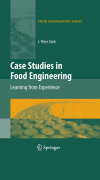
One of the best ways for students or practitioners to learn is through real-life example. In this volume, Clark presents several case studies that can be used not only by those currently working in the industry, but as a means for sparking discussion in food engineering classes. This book has several purposes:(1) to serve as a source of information about a representative collection of food processes with which Clark has had experience; (2) to convey some practical lessons about process development and plant design; and (3) to serve educators as a resource for class problems and discussion. The book is organized in three broad sections. The first concerns processes that are primarily physical, such as mixing. The second concerns processes that also involve biochemical changes, such as thermal sterilization. The third section addresses some broader issues that have not been discussed elsewhere, including how to tour a plant, how to choose among building a new plant, expanding or renovating; and how to develop processes. INDICE: About the Author. Preface. Introduction.- Section 1: Processes Based Largely on Physical Operations. Dry Mixing. Snacks and Baking. Breakfast Cereals. Pet Foods. Fruit and Vegetable Juice Processing. Membrane Processing. Freeze Drying.- Section 2: Processes Based on Biochemical Reactions and ThermalTreatment. Continuous Thermal Processing. Retort Pouch Foods. Ice Cream. Sausages and other meat products. Non-thermal processing.- Section 3: A few broader topics. Economic evaluation. Design of a new facility. How to tour a food plant. Build new, expand or upgrade? Developing Processes. Appendix.- References.
- ISBN: 978-1-4419-0419-5
- Editorial: Springer
- Encuadernacion: Cartoné
- Páginas: 157
- Fecha Publicación: 01/08/2009
- Nº Volúmenes: 1
- Idioma: Inglés
